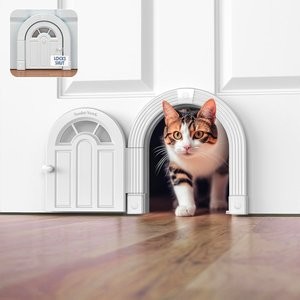Cats communicate in various ways, from subtle tail twitches to soft purrs. But when your feline companion starts crying, or meowing excessively, it’s their way of really trying to get your attention. Understanding the reasons behind these vocalizations is key to a happy and healthy relationship with your cat. While “cry” might be a human term, referring to the mournful sound we associate with sadness, in cats, it often encompasses a range of meows that signal different needs and emotions.
Here are some of the most common reasons why your cat might be crying, drawing on insights from veterinary experts and animal behaviorists.
1. The Hunger Games: Cries for Food
Just like clockwork, cats have an uncanny ability to know when it’s mealtime. If their food bowl is empty and their stomachs are rumbling, expect a chorus of meows, demanding to be fed. This behavior stems from their natural instincts and learned routines. Cats thrive on predictability, and meal times are a significant part of their daily schedule.
To manage these food-related cries, establish a consistent feeding schedule. Avoid varying feeding times drastically, as this can reinforce demanding meowing behavior. While it’s tempting to give in to those insistent meows with extra treats, resist the urge to become a 24/7 treat dispenser. Scheduled meals will help regulate their hunger and reduce excessive vocalizations.
2. Doorway Drama: Yearning for Freedom or Confinement
Cats often seem to have a perpetual desire to be on the other side of any door. Whether they are indoors wanting to explore the great outdoors, or outside yearning for the comfort of your home, cats use meows to request you to act as their personal doorman. This is especially common when they want access to rooms you might be in, or when you’ve inadvertently separated them.
Have you ever experienced your cat meowing outside the bathroom door or your bedroom door at night? Chances are, they simply want to join you and are using vocalizations to achieve their goal.
For cats who crave outdoor access, consider installing a pet door leading to a secure catio or a safe part of your yard. For indoor situations, ensure they have access to most areas of your home to minimize feelings of confinement and the associated meowing.
Alt text: Interior cat door installed in a home setting, providing cats freedom to move between rooms.
3. The Need for Connection: Attention-Seeking Meows
Cats, despite their independent reputation, are social creatures, especially with their beloved humans. They can easily become bored or lonely, and when subtle paw-pats and gentle nudges don’t suffice, they may resort to crying to solicit your attention for petting, playtime, or simply companionship.
Make a conscious effort to engage with your cat regularly. Schedule dedicated playtime and cuddle sessions. Ignoring their initial attempts to interact might lead to escalated meowing in the short term, and potentially a more distant relationship in the long run. Reciprocate their affection and initiate interaction yourself to fulfill their social needs and reduce attention-seeking cries.
Alt text: A person plays with a cat using a feather wand toy, engaging in interactive playtime.
Alt text: A variety pack of colorful catnip toys designed for playful batting and chasing.
4. Personal Space Please: Meows of Annoyance
Cats are known for their boundaries, and forcing them into situations they dislike can trigger vocal protests. For instance, cats often meow in complaint when held for longer than they find comfortable. Respecting their limits is crucial to avoid escalating their displeasure.
Pay close attention to your cat’s body language. Signs like flattened ears, a twitching tail, or a tense posture are indicators of discomfort or annoyance. Stop whatever you are doing that is causing their distress before the meows escalate into hisses or even bites. Understanding and respecting their boundaries builds trust and prevents negative associations with interaction.
5. Fearful Felines: Cries of Distress
When fear grips a cat, their initial reaction might be protest meows. These vocalizations can quickly escalate into growls and hisses if the perceived threat persists. However, a truly terrified cat might retreat and become silent, choosing to hide rather than draw attention to themselves.
Identifying and removing the source of fear is paramount to alleviating your cat’s anxiety. If the fear is triggered by environmental factors like loud noises, create a safe and quiet space for them. For persistent anxiety, pheromone products, such as Feliway diffusers, can create a calming atmosphere. Consulting with your veterinarian is also advisable to rule out underlying medical issues and discuss further anxiety management strategies.
Alt text: Feliway MultiCat calming diffuser plugged into an outlet, designed to release pheromones to reduce cat stress.
6. Health Concerns: Meowing as a Symptom
While cats are masters at concealing illness, changes in their vocalization patterns can be a sign that something is amiss. Some cats might cry before vomiting or coughing up hairballs. Furthermore, certain health conditions, such as hypertension, cognitive dysfunction in older cats, and deafness, can lead to increased meowing due to discomfort, confusion, or anxiety.
If you notice a sudden increase in your cat’s meowing, or if the nature of their meow changes (becoming more distressed or persistent), it is essential to schedule a veterinary check-up. Ruling out underlying medical issues is crucial, as early diagnosis and treatment can significantly improve your cat’s well-being.
7. The Chatty Breed: Vocal by Nature
Some cat breeds are simply more talkative than others. Breeds like Siamese, Bengal, Tonkinese, and Sphynx are known for their vocal nature and tendency to “talk” frequently. This is often just a part of their breed personality and not necessarily indicative of a problem.
Engaging in conversation with these vocal breeds can actually encourage their chattiness, so respond as you see fit! If you enjoy a vocal companion, these breeds can be a delightful choice. However, if you prefer a quieter feline friend, a less vocal breed might be a better match.
Understanding why your cat cries is the first step to addressing their needs and strengthening your bond. By paying attention to the context of their meows and considering these common reasons, you can become fluent in “cat speak” and ensure your feline companion is happy, healthy, and well-understood.


